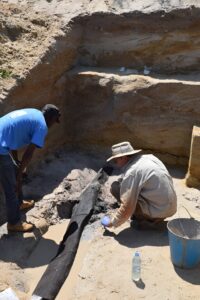 The well-preserved remains of a wooden structure that is no less than 476,000 years old, pre-dating the appearance of Homo sapiens by 100,000, have been discovered at Kalambo Falls in Zambia. Two logs were found in an interlocking position, joined by an intentionally cut notch. Early hominins whittled, shaped and stacked timbers into an unidentified structure that may have been a shelter, a raised track, a fishing platform or something else entirely.
The well-preserved remains of a wooden structure that is no less than 476,000 years old, pre-dating the appearance of Homo sapiens by 100,000, have been discovered at Kalambo Falls in Zambia. Two logs were found in an interlocking position, joined by an intentionally cut notch. Early hominins whittled, shaped and stacked timbers into an unidentified structure that may have been a shelter, a raised track, a fishing platform or something else entirely.
Professor Larry Barham, from the University of Liverpool’s Department of Archaeology, Classics and Egyptology, who leads the “Deep Roots of Humanity” research project said, “This find has changed how I think about our early ancestors. Forget the label ‘Stone Age,’ look at what these people were doing: they made something new, and large, from wood. They used their intelligence, imagination, and skills to create something they’d never seen before, something that had never previously existed.”
“They transformed their surroundings to make life easier, even if it was only by making a platform to sit on by the river to do their daily chores. These folks were more like us than we thought.”
 The Kalambo Falls site was first excavated in the 1950s, and while wood objects — including large ones that could have been part of a structure — were found in those early digs, their age could not be determined with the technology available at the time. Archaeologists returned to the site in the early 2000s to date the remains with modern techniques, and in 2019 they found several pieces of wood that showed signs of having been intentionally modified. There were whittled digging tools, a wedge-shaped block and one much larger find: a timber 4.6 feet long with tapered ends and a deeply-carved notch into which another large log was slotted perpendicular to the first like big, pre-modern human Lincoln Logs.
The Kalambo Falls site was first excavated in the 1950s, and while wood objects — including large ones that could have been part of a structure — were found in those early digs, their age could not be determined with the technology available at the time. Archaeologists returned to the site in the early 2000s to date the remains with modern techniques, and in 2019 they found several pieces of wood that showed signs of having been intentionally modified. There were whittled digging tools, a wedge-shaped block and one much larger find: a timber 4.6 feet long with tapered ends and a deeply-carved notch into which another large log was slotted perpendicular to the first like big, pre-modern human Lincoln Logs.
 The wood was preserved for half a million years in the waterlogged sediments of the Kalambo River. Radiocarbon dating relies on the half-life of carbon-14 (5,730 years), so its effectiveness is limited to archaeological or paleontological materials that are less than 60,000 years old. The wood was carbon dated just to cover all bases, and the dates were infinite (ie, more than 50,000 years old). In order to date organic remains that turned out to be more than eight times older than C-14’s limit, researchers used two different types of luminescence analyses on 16 sand samples collected from deposits containing the wood. The results dated the samples to at least 476 ± 23 thousand years ago.
The wood was preserved for half a million years in the waterlogged sediments of the Kalambo River. Radiocarbon dating relies on the half-life of carbon-14 (5,730 years), so its effectiveness is limited to archaeological or paleontological materials that are less than 60,000 years old. The wood was carbon dated just to cover all bases, and the dates were infinite (ie, more than 50,000 years old). In order to date organic remains that turned out to be more than eight times older than C-14’s limit, researchers used two different types of luminescence analyses on 16 sand samples collected from deposits containing the wood. The results dated the samples to at least 476 ± 23 thousand years ago.
No hominin remains have been discovered at Kalambo Falls to identify which ancestors of modern humans made this wood structure. A Homo heidelbergensis skull dating to 300,000 years ago has been found at another site in Zambia, so that’s one possibility.
This extraordinary find has been published in the journal Nature and can be read here.